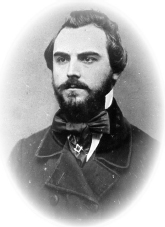CHAPTER TEN

The Yankees Crossed Fired on Us a Good While
The bloody repulse of Edward O’Neal’s disjointed attack signified the prelude of the heavy and difficult fighting Rodes’ Division would perform that warm July afternoon.
If Alfred Iverson’s report is any indication, Rodes’ offensive plan in general—and for Iverson’s command in particular—was not well spelled out or understood. Before any attack began, Iverson received “instructions from General Rodes to advance gradually to the support of a battery he intended placing” on the southern slope of Oak Hill. These orders left him confused and frustrated. “[Not] understanding the exact time at which the advance was to take place, I dispatched a staff officer to him, to learn at what time I was to move forward, and received instructions not to move until my skirmishers became hotly engaged,” wrote Iverson in his report.
A short time later, Iverson obtained some clarification from Rodes: “I received an order from him to advance to meet the enemy, who were approaching to take the battery.” The division commander instructed Iverson to coordinate his actions with O’Neal on his left and to call on Junius Daniel for any needed support. Iverson “immediately dispatched a staff officer to inform Brigadier-General Daniel that I was about to advance, and one to notify my regiments, and to observe when the brigade on my left [O’Neal] commenced to move.”1
In a rare display of tactical ineptness, Rodes had completely misread the situation confronting him. The Federal troops that he believed were threatening his batteries turned out to be nothing more than a heavy skirmish line. Iverson, however, set up for the attack without deploying any additional skirmishers along his own front line because the enemy troops Rodes ordered him to assault were visible in the field—and nothing appeared to be between them and the Tar Heel line of battle. The sharpshooter detachment remained just west of the McLean farmhouse, assigned to protect the left flank of the brigade. The domino effect of these decisions would soon have terrible ramifications far beyond what anyone could have imagined.2
By the time Iverson was in position, Federal skirmishers had halted well short of the Confederate lines and showed no inclination to attack the Oak Hill batteries. “The enemy did not advance as he was expected to do, but in a few minutes an order was received to follow up any movement of the Brigade on our left,” Capt. Benjamin Robinson of the 5th North Carolina wrote Governor Zeb Vance. “Just then the Brigade of Col. O’Neal commenced to march forward.” Instead of waiting for clarification of the situation, Iverson responded to his orders by launching his regiments across the field.3
While the Confederates were preparing to attack, Henry Baxter realigned his men to meet the impending threat against his left flank. After repulsing O’Neal’s Brigade, the Federal brigade commander shifted the 88th Pennsylvania and the 83rd New York from their positions along the Mummasburg Road into place behind the stone wall running along the top of the ridge on the southeast side of the Forney farm field. Baxter noted that his troops “changed front to the left and moved forward to the crest of the hill” just as Iverson’s men appeared along their front. Lieutenant George Grant from the 88th Pennsylvania recalled that this movement placed them in “an admirable position on the crest of the ridge behind a low stone wall.”4